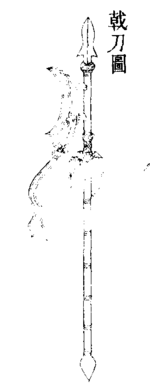Ji (polearm): Difference between revisions
Underbar dk (talk | contribs) No edit summary |
No edit summary |
||
| Line 2: | Line 2: | ||
{{unreferenced|date=December 2007}} |
{{unreferenced|date=December 2007}} |
||
[[File:Halberd.png|thumb|150px|A ''ji'', from the Qing dynasty encyclopedia ''[[Gujin Tushu Jicheng]]'']] |
[[File:Halberd.png|thumb|150px|A ''ji'', from the Qing dynasty encyclopedia ''[[Gujin Tushu Jicheng]]'']] |
||
The '''ji''' ({{zh|戟|''jǐ''}}), the [[China|Chinese]] [[halberd]], was used as a military [[weapon]] in one form or another from at least as early as the [[Shang dynasty]] until the end of the [[Qing dynasty]]. They are still used for training purposes by many [[Chinese martial arts]]. |
The '''ji''' ({{zh|戟|''jǐ''}}), the [[China|Chinese]] [[halberd]], was an ancient [[pole arm]] used as a military [[weapon]] in one form or another from at least as early as the [[Shang dynasty]] until the end of the [[Qing dynasty]]. They are still used for training purposes by many [[Chinese martial arts]]. |
||
The ''ji'' is initially a hybrid between a [[Qiang (spear)|Chinese spear]] and a [[dagger-axe]], another common [[Bronze Age]] weapon. It was a relatively common infantry weapon in [[Ancient China]], although it was used by [[cavalry]] and [[charioteer]]s as well. There were several variant types of ''ji'', e.g. with a rectangular, serrated blade instead of the crescent-formed one, or spear tips with two curved blades attached. |
|||
They have two or three sharp points of attack, the side blade or blades and the tip, plus often a rear counter weight that could be used to strike the opponent. The way the side blades are fixed to the main spear pole differs, but usually there are empty spaces between the pole and the side blade. The wielder could strike with the shaft, with the option of then pulling the halberd back to hook with a side blade; or slap his opponent with the flat side of the halberd blade to knock him off his horse. |
They have two or three sharp points of attack, the side blade or blades and the tip, plus often a rear counter weight that could be used to strike the opponent. The way the side blades are fixed to the main spear pole differs, but usually there are empty spaces between the pole and the side blade. The wielder could strike with the shaft, with the option of then pulling the halberd back to hook with a side blade; or slap his opponent with the flat side of the halberd blade to knock him off his horse. |
||
Revision as of 17:21, 8 May 2014

The ji (Chinese: 戟), the Chinese halberd, was an ancient pole arm used as a military weapon in one form or another from at least as early as the Shang dynasty until the end of the Qing dynasty. They are still used for training purposes by many Chinese martial arts.
The ji is initially a hybrid between a Chinese spear and a dagger-axe, another common Bronze Age weapon. It was a relatively common infantry weapon in Ancient China, although it was used by cavalry and charioteers as well. There were several variant types of ji, e.g. with a rectangular, serrated blade instead of the crescent-formed one, or spear tips with two curved blades attached.
They have two or three sharp points of attack, the side blade or blades and the tip, plus often a rear counter weight that could be used to strike the opponent. The way the side blades are fixed to the main spear pole differs, but usually there are empty spaces between the pole and the side blade. The wielder could strike with the shaft, with the option of then pulling the halberd back to hook with a side blade; or slap his opponent with the flat side of the halberd blade to knock him off his horse.
